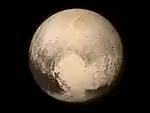HD 219134 g
HD 219134 g, also known as HR 8832 g, is an unconfirmed exoplanet orbiting around the K-type star HD 219134 in the constellation of Cassiopeia. It has a minimum mass of 11 Earth Masses, suggesting that it could be a high-mass ocean planet or a Neptune-like ice giant. Unlike HD 219134 b and HD 219134 c it was not observed by the Spitzer Space Telescope and thus its radius and density are unknown. It resides closer to the star than the inner edge of the system's (empirical) habitable zone, defined by the recent Venus limit.[3] If it has an Earth-like composition, it would have a radius 1.9 times that of Earth. However, since it is probably an ocean planet or Mini-Neptune, it is likely larger.
| Discovery | |
|---|---|
| Discovered by | HARPS-N |
| Discovery site | La Palma, Canary Islands |
| Discovery date | 2015 November 17 |
| radial velocity method | |
| Orbital characteristics | |
| 0.3753 (± 0.0004)[1] AU | |
| Eccentricity | 0[1] |
| 94.2 (± 0.2)[1] d | |
| Inclination | null[1] |
| Star | HD 219134 |
| Physical characteristics | |
Mean radius | ~2.4 R⊕ |
| Mass | >10.81 (± 1.27)[1] M⊕ |
| Temperature | 298 K (25 °C; 77 °F)[2] |
Characteristics
Mass, Radius, and Temperature
HD 219134 g is a sub-Neptune-mass exoplanet with a minimum mass of 10.81 M⊕ and an unknown radius, as it is not known to transit.[1] However, due to the high metal content of the host star, the planet might not be an ice giant. For a rock-iron composition, HD 219134 g would be about 1.9 R⊕, which seems unlikely for a planet of this mass. A more plausible rock-water composition would put the planet at about 2.4 R⊕. In the absence of an atmosphere, and assuming an albedo of 0.3, it has an equilibrium temperature of 298 K (25 °C; 77 °F), but with an atmosphere it is likely to have a surface temperature much higher, that is if it has a rocky surface. So, it is rather unlikely to be habitable.
Orbit
HD 219134 g takes about 94.2 days to orbits its star at a distance of 0.3753 AU. This is comparable to Mercury's orbit of 88 days at about 0.38 AU. However, due to the lower luminosity of the host star, HD 219134 g is closer to Venus' situation. The eccentricity of the planet's orbit is believed to be close to zero, indicating a very circular orbit.[1]
Host Star
The planet HD 219134 g orbits the K3V orange dwarf HD 219134, also known as HR 8832. It is 79% the radius and 80% the mass of the Sun with 26% the luminosity. It has a temperature of 4699 K and is around 11 billion years old.[1] For comparison, the Sun has a temperature of 5778 K and is 4.55 billion years old.
The apparent magnitude of the star, or how bright it appears from Earth, is around 5. Therefore, it is just visible to the unaided eye to most observers.
Habitability
HD 219134 g could be a potentially habitable planet. Based on its relatively low mass (~11 M⊕) and the high metal content of the parent star (+0.11 [Fe/H]), it has a low chance of being an ocean planet. While these types of worlds have no solid surfaces for life to develop, it is predicted that biology would arise in ways other than that of Earth. The planet also appears to have a fairly similar temperature to Earth, if somewhat hotter than Earth's 255 K (−18 °C; −1 °F) equilibrium temperature. HD 219134 g has an equilibrium temperature of 298 K (25 °C; 77 °F), in fact exactly the same as Venus' equilibrium temperature, that is if Venus like Earth had an albedo of 0.3.[2] However, the planet was not reported in the most recent analysis of the system with the HARPS-N spectrograph, which suggests that the planet may not actually exist. Although, even if the planet did exist, but wasn't tidally locked, it would not fit the understood criteria for being located within the star's habitable zone. For example, the habitable zone for this star, as defined by Kopparapu et al. 2014,[4] for a 5 Earth mass planet, would be between 0.499 AU and 0.947 AU.[note 1][3]
References
- "HD 219134 g". exoplanetarchive.ipac.caltech.edu. Retrieved 2017-12-24.
- "HEC: Exoplanets Calculator". phl.upr.edu. Retrieved 2017-12-24.
- "Habitable Zone Calculator". Department of Geosciences, Penn State. Retrieved 2018-12-30.
- Kopparapu, Ravi Kumar; Ramirez, Ramses M.; SchottelKotte, James; Kasting, James F.; Domagal-Goldman, Shawn; Eymet, Vincent (15 May 2014). "Habitable Zones Around Main-Sequence Stars: Dependence on Planetary Mass". The Astrophysical Journal Letters. 787 (2): 6. arXiv:1404.5292. Bibcode:2014ApJ...787L..29K. doi:10.1088/2041-8205/787/2/L29.
- Kopparapu, R. K.; Ramirez, R.; Kasting, J.F.; Eymet, V.; Robinson, T. D.; Mahadevan, S.; Terrien, R.C.; Domagal-Goldman, S.; Meadows, R.; Deshpande, V. (March 2013). "Habitable Zones Around Main-sequence Stars: New Estimates". The Astrophysical Journal. 765 (2): 16. arXiv:1301.6674. Bibcode:2013ApJ...765..131K. doi:10.1088/0004-637X/765/2/131.
Notes
- [4] when used to calculate the stellar flux reaching the outer atmosphere of a 5 mass Earth-like planet orbiting HD 219134 at the Inner Habitable Zone edge - the Runaway Greenhouse limit gives a of 1.0615 or 106.15% the stellar flux reaching the top of Earth's atmosphere. By applying the previously calculated stellar flux and the known 26.46% luminosity of HD 219134 into the equation, ,[4][5] the distance of the Inner HZ - Runaway Greenhouse limit from HD 219134 can be calculated as .


